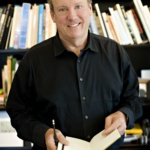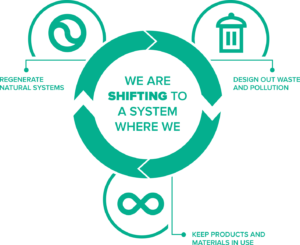Currently, about 2.01 billion metric tons of waste are produced annually worldwide and only a fraction of that is recycled or composted. The World Bank estimates overall waste generation will increase by 70% by 2050. In a world full of waste, what products and services does the world truly need?

Dave Weatherhead, Managing Director of Kinesys
“Business should ultimately aim to give people jobs that improve their lives and to produce products and services that improve the world.”
Dave Weatherhead, Managing Director of Kinesys
New York University Center for Sustainable Business (CSB) has identified a growing consumer demand of sustainability-marketed products, however these currently only account for under 17% of the current market. But does sustainability as we understand it enhance the world?

William McDonough, author
“I ask myself occasionally if the word sustainability is the right word to use. If sustainability is just maintenance, perhaps we can go beyond it. Is being less bad being good?”
William McDonough, co-author of Cradle-to-Cradle
Designing products and services that last
Reduce, reuse, recycle. We are all now familiar with this slogan. However, it is still only recycling that has really taken off.
The problem is, that if we design products that go to waste after a certain lifespan, even if we recycle, the raw material loses value. There is energy lost along the product lifespan, throughout research and development, production, transport, maintenance and the recycling process. Many industries design their products to break after a certain period of time so they can be replaced by a new (possibly improved) version – so called “planned obsolescence” .
“I see design as a signal of human intention. We need to stop designing things for end-of-life, designing for next use is just a different way of thinking.”
William McDonough, co-author of Cradle-to-Cradle

Image: Ellen MacArthur Foundation infographic
The image above presents three principles of a circular approach for product design. Waste and pollution are largely a product of how we design and so can be designed out. Keeping products in use is all about reusing, repairing and remanufacturing. Regenerating natural systems is making sure that every end of use /spare resource is food for another sector.
Creating space for learning and innovation
Traditional innovation processes tend to leave out the bigger ecosystem picture and to focus on satisfying consumer demands. There is a need to map raw material flows, energy use and stakeholders in order to develop a balanced approach that creates value for all that are involved.
“The current linear economy is following a cradle-to-grave model, we are looking at eliminating the concept of waste using biological and technical nutrients.”
William McDonough, co-author of Cradle-to-Cradle
No matter if you apply human-centred design, design thinking, biomimicry or circular design processes, a circular design approach includes ecosystem awareness in every step of the product and service innovation process.
Offering services rather than products
One way to radically reducing material use is to move from offering to sell a product to selling a service. Offering products as a service is a model which returns the ownership and responsibility of the product back into the hands of the producer. Selling a product as a service makes energy efficiency and sustainability profitable. It makes cutting costs through designing for disassembly and resource recovery attractive. Modular design becomes the default for designers, making extending the life of the product attractive.
A good example of this approach is Philips’ selling of light as a service rather than lighting units as a product. With a 5-year service agreement to supply lighting in Schipol airport, designing lighting units to be easily repairable makes financial sense for Philips and reduces the price to the client.
For Riversimple, a company featured in another case study in the guide, they include not only all elements of car ownership in their service offer – the vehicle, repair, insurance but also the (hydrogen) fuel. This allows them to exercise their greater buying power to keep down (hydrogen) fuel costs.
Moving towards a circular economy
As we move towards a circular economy, we start seeing more opportunities in stakeholder collaboration. Suddenly organizations like Circle Economy find that a neighbourhood community can benefit from the heat created during the manufacturing process of a nearby factory, sharing platforms can facilitate the exchange and reuse of goods and we can benefit from open design processes that involve citizens to solve local challenges, like with OpenIdeo.
A circular economy system is one where collaboration prevails and where there is no need for patents and idea ownership. An example here are Tesla and Riversimple. The real value is created through expertise, mutual benefit and collaboration. Learn more about the circular economy here. All the concepts mentioned in this article talk to the wellbeing economy – the wellbeing of the planet.
- Case study: Unusual rigging – prolonging life
- This is an extract from the forthcoming ‘The Business of Wellbeing – Alternatives to Business as Usual’ Guide, launching in January 2020. For more extracts, please click here
- To stay informed of the release of each extract, please sign up to our newsletter here.
the discussion?
Let us know what
you would like
to write about!
